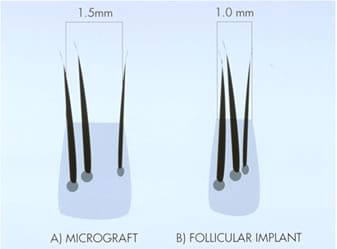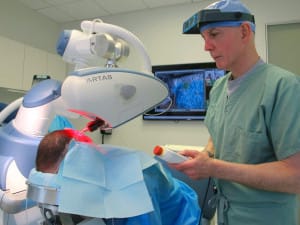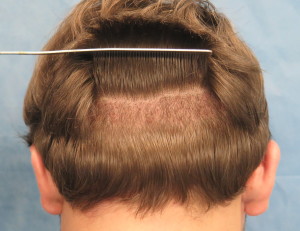The Early Years – “Plugs”
The first hair transplant surgery for male pattern baldness was performed by Dr. Norman Orentreich in 1952 in New York City. After a disbelieving medical community rejected the first few submissions of his paper, this landmark study was finally published in 1959. Dr. Orentreich coined the term “donor dominance” to explain the basic principle of hair transplantation which says that transplanted hair continues to display the same characteristics of the hair from where it was taken. In other words, healthy hair that is harvested from the back or side of the scalp (the permanent zone) will continue to grow as if it were still in its original location. Donor dominance explains why hair in the donor area, which is resistant to balding, continues to grow after it is transplanted to the thinning or bald areas of the scalp.
Unfortunately, excitement over this discovery took the focus away from the reality that merely getting the hair to grow did not guarantee a successful cosmetic result. In fact, the 4-mm large grafts of skin and hair used by Dr. Orentreich — grafts the width of pencil erasers — made a natural result virtually impossible. Throughout the 1970s, all hair transplant procedures used large grafts, which became commonly known as “hair plugs,” and the term “hair plugs” became synonymous with hair transplantation in popular culture. For years, these large grafts represented the only surgical option, so patients, wanting to have their hair restored, accepted the less-than-optimal outcomes.
Mini-Grafts and Micro-Grafts

In 1984, “mini-grafting,” the technique of using smaller grafts cut from a strip of donor tissue, rather than punched out directly from the back of the scalp, was introduced to the field of hair restoration. Physicians began using “micro-grafts,” even smaller grafts of 1-2 hairs, to soften the frontal hairline. The procedure that used mini-grafts in the center of the scalp with micro-grafts placed around them to make them look more natural was called “mini-micro” grafting. Mini-micro grafting procedures gradually supplanted the plug technique and became the main form of hair restoration surgery over the next 20 years (i.e. through the 1990’s). Other methods of hair restoration surgery – such as scalp reductions and flaps – similarly resulted in unnatural-looking results.
The use of very large numbers of mini-micro grafts — a technique called “Mega-sessions” — gained popularity in the mid-1990s. To increase the size of the hair transplant sessions was a logical extension of the mini-micrografting technique, as it required basically the same skills of the smaller sessions. The problem with mini-micrografting was that the grafts sizes were arbitrary and did not mimic that which occurred in nature. Mini-grafts can look a bit pluggy and micro-grafted areas can appear too thin. In addition, in the mini-micrografting technique, the skin between follicular units was not trimmed away, necessitating larger than necessary recipient sites, larger wounds, and more variable healing and graft growth.
Follicular Unit Transplantation
- More about Hair Transplantation
- Before & After Hair Transplant Photos
- Hair Transplant FAQ
- Answers
- Physician Consult
In 1994, on a visit to the office of Dr. William Rassman in Los Angeles, Dr. Bernstein was inspired with an idea that would permanently transform the industry. His idea was to only transplant grafts of naturally-occurring units of one to four hairs called follicular units.
The introduction of Follicular Unit Transplantation (FUT) by Drs. Bernstein and Rassman in 1995, in which stereo-microscopic graft dissection (based on the dissection technique of Dr. Bobby Limmer) is used to obtain follicular units from a donor strip, dramatically improved outcomes, but also increased the skills required by the surgeon and staff to perform hair transplants.
Follicular Unit Transplantation was initially met with great skepticism and resistance by the hair restoration community. After a groundswell of patient demand, mostly fueled by patients touting their great results over the internet, physicians reluctantly adopted the technique. By the year 2000, FUT hair transplant procedures had become mainstream and soon after FUT became the “gold standard” for surgical hair restoration. The important events in the history of Follicular Unit Transplantation can be found in the section Milestones in the History of FUT.
Follicular Unit Extraction
Dr. Orentreich’s idea of harvesting grafts directly from the back of the scalp, rather than harvesting from a donor strip, never fully dissipated even though FUT was the procedure of choice for most patients. Since physicians had become accustomed to performing follicular unit-based hair transplants, an Australian doctor began to investigate the idea of removing these naturally-occurring units directly from the donor area using a very tiny punch. The idea gained popularity in the United States when Bernstein and Rassman worked on this technique and introduced “Follicular Unit Extraction (FUE)” into the medical literature in their 2002 publication, Follicular Unit Extraction: Minimally Invasive Surgery for Hair transplantation.
In FUE, an instrument is used to make a small, circular incision in the skin around a follicular unit, separating it from the surrounding tissue. The follicular unit is then pulled, or extracted, from the scalp, leaving a tiny hole (which heals in a few days). This process is repeated until a sufficient number of follicles are obtained.
Like FUT, FUE also faced initial resistance due to a new set of surgical skills required of the surgeon and staff. And since FUE requires a special device to extract whole follicular units, the race to develop the optimal instrument was on. Despite these hurdles, patient demand for a hair transplant procedure that did not leave a linear scar in the donor area began to grow.
FUE hair transplants gained further momentum with Harris’ paper in 2005, in which the concept of a two-step sharp/dull punch instrument for FUE was introduced. The two-step procedure uses a sharp-tipped instrument to first cut part of the way into the skin and then a second punch with a blunt tip to cut deeper into the dermis. This has proven to be important in minimizing the damage to the follicular units during extraction. Despite the advantages of the two-step procedure, some FUE tools such as the NeoGraft and SmartGraft systems, still use only a sharp punch. Several commonly used FUE instruments, such as the SAFE System and the ARTAS Robotic Hair Transplant System, use a sharp/blunt dual punch mechanism.
The popularity of FUE hair transplantation has exploded in recent years, although FUT is still widely performed. Both procedures have their advantages and limitations for different types of patients, so the ability to offer both procedures is seen by many practitioners as essential to providing patients with the best surgical options. The question of which procedure should be performed for a patient is largely determined by factors such as the looseness of the scalp, the length of hair worn by the patient, and the volume of hair desired in the hair restoration. See FUE vs. FUT: Comparison.
Robotic Follicular Unit Extraction
 Dr. Bernstein Using the ARTAS Robot to Perform Robotic FUE
Dr. Bernstein Using the ARTAS Robot to Perform Robotic FUERobotic Follicular Unit Extraction (R-FUE) is a surgical hair restoration procedure in which a physician-controlled, computerized device uses a precision three-dimensional optical system to locate and harvest follicular units directly from the donor area. Restoration Robotics, Inc. introduced robotic hair transplantation to the field of hair restoration in 2011 when it launched the first ARTAS Robot.
The ARTAS Robot, the most advanced technology in hair restoration, aids the physician in the extraction of grafts and the creation of recipient sites with precision and consistency that surpasses manual techniques. An image-guided robotic arm deploys the dual-needle punch ensuring accuracy in each harvest. The robot can be used in patients with different hair characteristics, from different ethnic backgrounds, and from different parts of their scalp. Although only approved for use in men, it is effective for patients of both sexes.
Dr. Bernstein was an early adopter of robotic technology and in 2011 Bernstein Medical became one of the first hair restoration facilities in the world to incorporate the ARTAS system into a clinical practice. Dr. Bernstein has worked with Restoration Robotics on enhancements to the ARTAS robot and development of new capabilities since it became commercially available. Bernstein Medical serves as a beta-test site for developments and upgrades to the robotic system.
Robotic Recipient Site Creation
In 2013, Restoration Robotics, in conjunction with Dr. Bernstein, launched the recipient site creation capability of the ARTAS Robot. This feature allows the robot to perform one more key step in the hair transplant procedure, the creation of recipient sites in the balding areas where follicular unit grafts are placed. Dr. Bernstein discussed robotic recipient site creation in his 2014 publication in Hair Transplant Forum International, “Robotic Recipient Site Creation in Hair Transplantation.” In this process, the physician programs the robot with the specific angle and direction of the incisions, the site depth, average density and total number. The robot then executes this plan while the computer keeps track of the total number of sites.
Long-Hair Robotic FUE
Dr. Bernstein introduced the Long-Hair Robotic FUE technique in 2015 to solve the short-term cosmetic problem of having to shave the patient’s entire donor area for an FUE procedure. In Long-Hair FUE, the physician harvests follicular units from a patient’s donor area with longer hair by taping the long hair up and shaving one or more strips in the back and sides of the scalp. After harvesting follicular units from those shaved strips, the remaining hair can be lowered, completely covering and camouflaging the post-operative site.
Robotic Graft Selection
In 2016, Dr. Bernstein published a paper on his concept of Robotic Follicular Unit Graft Selection which became a new capability of the ARTAS robot. Restoration Robotics and Dr. Bernstein developed an algorithm by which the ARTAS System can automatically select follicular units for harvesting based on the number of hairs they contain. By adding this capability, robotic procedures can harvest more hair while minimizing wounding. As a result of robotic graft selection, Robotic FUE can produce greater hair density while leaving fewer scars in the donor area.
ARTAS 9x Hair Transplant System
 ARTAS 9x – White vs Red LED Light
ARTAS 9x – White vs Red LED LightRestoration Robotics released another milestone upgrade to the ARTAS System in 2017 with ARTAS 9x. Dr. Bernstein presented these upgrades at the 2017 Annual Meeting of the ISHRS that was held in Prague. The system includes hardware and software modifications such as a robotic base extender, more comfortable headrest and halo, white light LED, color camera and tensioner, 20-gauge harvesting needle, improved scar detection, faster harvesting, and improved ARTAS Hair Studio software.
The ARTAS 9x has an extender at the base of the arm that increases the robot’s mobility and reach, without increasing the size and weight of the robot itself. This larger reach makes the experience more comfortable for the patient because they are repositioned in the chair less frequently than with past versions. This also makes the procedure faster.
The ARTAS 9x software has scar detection capability which can detect areas with low (or no) hair density and block out those areas from harvesting. This step was done manually with other versions of the robot. By incorporating scar detection into the robot’s software, the procedure is sped up and over-harvesting from low-density areas is minimized.
The ARTAS 9x robot was modified to use a white LED light instead of a red light because the red LED light was harsher on the eyes. By switching to the white light, dissected follicular units can be removed from the scalp while the robot is working. These, along with many other components of the robotic system, aim to improve yield and minimize transection, leading to increasingly better outcomes.






Pingback: A Comparison of Synthetic Sutures and Staples in Hair Transplants | Hair Loss For Men Solutions